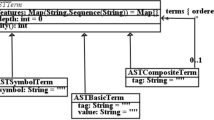Abstract
In this article we present a method for describing the language of UML statecharts. Statecharts are syntactically defined as attributed graphs, with well-formedness rules specified by a set of first-order predicates over the abstract syntax of the graphs. The dynamic semantics of statecharts is defined by Abstract State Machines parameterized with syntactically-correct attributed graphs. The presented approach covers many important constructs of UML statecharts, including internal, completion, interlevel and compound transitions as well as history pseudostates. It also contains strategies to handle state entry/exit actions, state activities, synch states and choice pseudostates.
Similar content being viewed by others
References
Moses project (1997) Computer Engineering and Communications Laboratory, ETH Zurich. http://www.tik.ee.ethz.ch/∼moses
Bardohl R, Taentzer G, Minas M, Schürr A (1999) Application of graph transformation to visual languages. In: [8]
Börger E, Cavarra A, Riccobene E (2000) Modeling the dynamics of UML state machines. In: Proc. Abstract state machines, LNCS, vol 1912, pp 223–241
Börger E, Cavarra A, Riccobene E (2001) Solving conflicts in UML state machine concurrent states. In: Workshop on Concurrency Issues in UML, UML’01, pp 4–7
Börger E, Cavarra A, Riccobene E (2003) Modeling the meaning of transitions from and to concurrent states in UML state machines. In: ACM Symposium on Applied Computing, pp 1086–1091
Compton K, Huggins J, Shen W (2000) A semantic model for the state machine in the Unified Modeling Language. In: Workshop on Dynamic Behavior in UML Models: Semantic Questions, UML’00, pp 25–31
Ebert J, Winter A, Dahm P, Franzke A, Süttenbach R (1996) Graph based modeling and implementation with EER/GRAL. In: Proc. Conceptual Modeling, LNCS, vol 1157. Springer, pp 163–178
Ehrig H, Engels G, Kreowski H-J, Rozenberg G (editors) (1999) Handbook of Graph Grammars and Computing by Graph Transformation, Volume 2: Applications, Languages and Tools. World Scientific
Eshuis R, Wieringa R (2000) Requirements level semantics for UML statecharts. In: Proc. Formal Methods for Open Object-Based Distributed Systems. Kluwer, pp 121–140
Esser R, Janneck JW (2001) Moses – a tool suite for visual modelling of discrete-event systems. In: IEEE Symposium on Visual/Multimedia Approaches to Programming and Software Engineering, HCC’01
Gogolla M, Parisi-Presicce F (1998) State diagrams in UML – a formal semantics using graph transformation. In: Workshop on Precise Semantics of Modeling Techniques, ICSE’98, pp 55–72
Gurevich Y (1994) Evolving algebras. In: IFIP 13th World Computer Congress, Volumn I: Technology/Foundations, pp 423–427
Harel D, Naamad A (1996) The STATEMATE semantics of satecharts. ACM Transactions on Software Engineering and Methodology 5(4):293–333
Harel D, Pnueli A, Schmidt JP, Sherman R (1987) On the formal semantics of statecharts. In: IEEE Symposium on Logic in Computer Science, pp 54–64
Holzmann GJ (1997) The model checker SPIN. IEEE Transactions on Software Engineering 23(5):279–295
Honeywell, Inc. (2000) DOME Guide. Version 5.2.2.
Institute for Software Integrated Systems (2001) GME 2000 Users Manual. Version 1.1. Vanderbilt University
Janneck JW (1998) Graph Type Definition Language (GTDL) – Specification. In [1]
Janneck JW (2000) Syntax and semantics of graphs – An approach to the specification of visual notations for discrete-event systems. PhD thesis, ETH Zurich
Janneck JW, Esser R (2001) A predicate-based approach to defining visual language syntax. In: Symposium on Visual Languages and Formal Methods, HCC’01
Janneck JW, Kutter PW (1998) Mapping automata – simple abstract state machines. Technical Report 49, Computer Engineering and Networks Laboratory, ETH Zurich
Jin Y, Esser R, Janneck JW (2002) Describing the syntax and semantics of UML statecharts in a heterogeneous modelling environment. In: Proc. Diagrammatic Representation and Inference, LNAI, vol 2317. Springer, pp 320–334
Jin Y, Esser R, Lakos C (2003) Lightweight consistency analysis of dataflow process networks. In: Proc. Australasian Computer Science Conference, pp 291–300
Jin Y, Esser R, Lakos C, Janneck JW (2003) Modular analysis of dataflow process networks. In: Proc. Fundamental Approaches to Software Engineering, LNCS, vol 2621, pp 184–199
Jürjens J (2002) A UML statecharts semantics with message-passing. In: ACM Symposium on Applied Computing. ACM Press, pp 1009–1013
Kuske S (2001) A formal semantics of UML state machines based on structured graph transformation. In: Proc. The Unified Modeling Language, LNCS, vol 2185, pp 241–256
Kwon G (2000) Rewrite rules and operational semantics for model checking UML statecharts. In: Proc. The Unified Modeling Language, LNCS, vol 1939. Springer, pp 528–540
Latella D, Majzik I, Massink M (1999) Towards a formal operational semantics of UML statechart diagrams. In: Proc. Formal Methods for Open Object-Based Distributed Systems. Kluwer, pp 331–347
Lilius J, Paltor IP (1999) Formalising UML state machines for model checking. In: Proc. The Unified Modeling Language, LNCS, vol 1723. Springer, pp 430–445
Minas M (2003) XML-based specification of diagram editors. In: Workshop on Uniform Approaches to Graphical Process Specification Techniques, ETAPS’03, ENTCS 82(7). Elsevier
Object Management Group (2003) OMG Unified Modeling Language Specification. Version 1.5, http://www.omg.org
Schäfer T, Knapp A, Merz S (2001) Model checking UML state machines and collaborations. In: Workshop on Software Model Checking, CAV’01, ENTCS 55(3). Elsevier Science B.V., pp 1–13
Taentzer G, Ermel C, Rudolf M (1999) The AGG approach: Language and tool environment. In: [8], pp 551–603
Varró D (2002) A formal semantics of UML statecharts by model transition systems. In: Proc. Graph Transformation, LNCS, vol 2505, pp 378–392
von der Beeck M (2002) A structured operational semantics for UML-statecharts. Software and System Modeling 1(2):130–141
Author information
Authors and Affiliations
Corresponding author
Rights and permissions
About this article
Cite this article
Jin, Y., Esser, R. & Janneck, J. A method for describing the syntax and semantics of UML statecharts. Softw Syst Model 3, 150–163 (2004). https://doi.org/10.1007/s10270-003-0046-6
Received:
Accepted:
Published:
Issue Date:
DOI: https://doi.org/10.1007/s10270-003-0046-6




